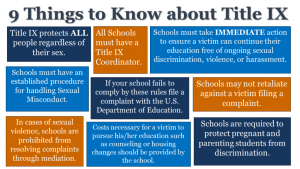June 23, 2022, marked the 50th anniversary of Title IX. AAUW contributed significantly to this foundational law for decades before and after its passage, transforming the lives of millions of women and girls.
What does Title IX aim to accomplish?
“No person in the United States shall, on the basis of sex, be excluded from participation in, be denied the benefits of, or be subjected to discrimination under any education program or activity receiving Federal financial assistance.” (2)
“Title IX of the Education Amendments of 1972 is a concise 37 words. Patterned after the Civil Rights Act of 1964, it affected, among other things, girls’ and women’s sports, college admissions, academic majors, vocational programs, teaching and coaching positions and even the handling of sexual assaults on campus. But nothing since its passage has been simple. From the beginning, legislators, policymakers and activists clashed as some tried to extend, and others to limit, the law’s reach and power.” (1)
Title IX requires recipients of federal education funding to evaluate their current policies and practices; adopt and publish a policy against sex discrimination, including sexual harassment and violence; and implement grievance procedures providing for prompt and equitable resolution of student and employee discrimination complaints. The law also prohibits retaliation for filing a Title IX complaint or advocating for those making a complaint. (3)
It’s not just about sports — Title IX affects all areas of education, including:
- recruitment, admissions and housing;
- career and technical education;
- pregnant, parenting, and/or married students;
- science, technology, engineering and math (STEM);
- sexual harassment and assault;
- comparable facilities and access to course offerings;
- financial assistance;
- student health services and insurance benefits;
- harassment based on gender identity; and
- athletics.
50 years later — what is Title IX’s impact?
As Title IX reaches its 50th year, it is instructive to look at the progress of women in educational institutions: (4)
| % of Women earning: | 1969 | 2018 (pre pandemic) |
| Bachelor Degree | 43% | 57% |
| Masters Degree | 39% | 61% |
| Doctorate | 10% | 54% |
The girls’ high school athletic participation rate is greater than 10 times what it was when Title IX was passed, an increase of more than 1,000 percent. However, current girls’ participation numbers have never reached the boys’ 1971-72 level. In 1972, when Title IX was passed, boys’ participation numbers were 3,666,917, which is 324,591 more than girls had in 2016.
Both women’s and men’s NCAA championship sports participation opportunities have increased every year since Title IX was passed. In 2015-16, a record number of male and female student-athletes participated in NCAA championship sports. Division I has the highest female participation rate, with 46.7 percent of opportunities for women, who are on average 53 percent of the undergraduate population on Division I campuses. Female student-athletes have 41.7 percent of the championship sport opportunities offered by Division II, a slight increase from five years ago. Division II has a participation gap of 16.6 percent between men and women. Since 2002, the Division III female participation rate as compared to the men’s rate has decreased slightly. Division III has the largest participation gap between men and women of the three NCAA divisions. (4)
Despite the greater number of women earning degrees since the passage of Title IX and their increasing participation in sports, great disparities remain. Conditions surrounding discrimination, harassment, and assault on campus present obstacles to female educational attainment. Though female athletic participation has increased, funding, facilities, and perquisites are not equal.
Proposed legislation to strengthen Title IX
AAUW supports federal legislation that strengthens students’ civil rights protections and Title IX enforcement, including comprehensive training and support for Title IX coordinators.
The Gender Equity in Education Act (GEEA) would provide educational entities and Title IX coordinators the resources, training, and technical assistance necessary to ensure equity in education and would establish an Office of Gender Equity in the Department of Education to coordinate interagency enforcement of Title IX. GEEA would also authorize competitive grants to K-12 schools, colleges, local educational agencies, or states to support their gender equity work.
The Title IX Take Responsibility Act of 2021 would amend Title IX to further define the actions educational institutions must take to prevent and correct the impacts of sexual harassment and assault, requiring more employees at schools to respond if they become aware of sex discrimination and holding institutions liable if they do not respond to sexual harassment with reasonable care. The bill would also allow students to sue their college or university over failure to enforce these rights under the established standards and allows for equitable relief for survivors. (3)
What actions can you take now to strengthen Title IX at age 50?
Use this tool to support the Gender Equity in Education Act (GEEA):
https://www.aauw.org/act/two-minute-activist/geea/
Call your Congressperson or Senator to let them know you support the Stop Sexual Harassment in K-12 Act reintroduced by Illinois Congressman Sean Casten.
Sources:
- https://www.nytimes.com/2022/04/27/arts/design/new-york-historical-society-title-ix-50.html
- https://www2.ed.gov/about/offices/list/ocr/docs/tix_dis.html#:~:text=Title%20IX%20states%3A,activity%20receiving%20Federal%20financial%20assistance.
- https://www.aauw.org/resources/policy/position-title-ix/
- https://nces.ed.gov/programs/digest/d20/tables/dt20_318.10.asp
Additional Reading:
https://www.aauwarizona.org/advocacy/2678-2/
https://www.aauw.org/app/uploads/2022/01/Title-IX-Quick-Facts-Jan-2022.pdf

